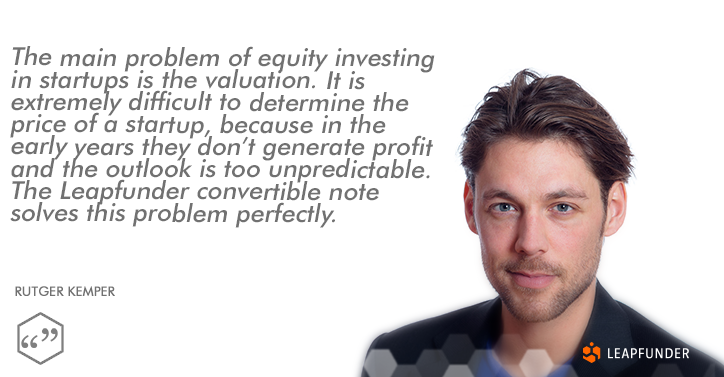At Leapfunder, we help startups find early-stage financing. We do that via the Leapfunder Convertible Note. In this blog-series, we will interview a number of investors who invest regularly via Leapfunder, and startups who have successfully raised financing with Leapfunder. Today we interview one of our regular investors, Rutger Kemper.

Inside the mind of Rutger Kemper
1. Hi Rutger! Could you first tell us a bit about your background and what made you decide to invest in startups?
I have been investing in stocks, bonds, commodities etc. since I attended high school. Also, during my years as a student, I have been working on setting up startups. I perceive it to be extremely rewarding to try to make a business thrive and excel. So whenever I see a startup passing by with a great idea, enthusiastic team and market potential I am interested in getting to know the startup better. I also like the fact that investing in startups is risky business. Most startups actually fail, but if you find one and your analysis or gut feeling tells you to invest, and the startup eventually becomes a success, it’s just something special.
2. What made you decide to invest in startups using Leapfunder? What is your experience and how hard is it to invest via Leapfunder?Leapfunder solves a big problem concerning investing in startups: There is little transparency in the market, and investors looking for great startups and startups looking for investors have difficulties to find one another. Leapfunder creates a platform for startups to be seen and it gives investors the rights tools to invest. Further, Leapfunder is plug and play. It makes investing in startups really easy. That, in combination with the Leapfunder Note makes it a great platform from which both investors and startups can benefit.
3. What in your opinion is the main benefit of using convertible notes? Do you ever invest using straight equity?
I invest in straight equity of listed companies, but investing in equity stakes of startups is really something else. The main problem of equity investing in startups is the valuation. It is extremely difficult to determine the price of a startup, because in the early years they don’t generate profit and the outlook is too unpredictable. The Leapfunder convertible note solves this problem perfectly. It is also a financial solution which, for me as an investor, is trustworthy and easy to understand. Another advantage of Leapfunder is that you can decide how much you want to invest, meaning that relatively small amounts can also be committed. This way, the investment possibilities are opened up to many investors.
4. What do you look for when investing in a company? Do you mind being the first to invest?
I have a list of different aspects I analyse when investing in a startup. When my analysis of the business concept of the startup is positive and I have a comfortable feeling with the team I am ready to invest. It doesn’t matter to me if I am the first or last.
5. A month ago, you attended the Startupbootcamp Amsterdam Demo Day of Class 2014. Most of those startups are currently in the process of negotiating with investors. In short, what would you say are some of the DOs and the DON’Ts in managing the relationship with potential angel investors? What action would help getting them on board and what would be a mistake?
If you are talking to investors about financing; be honest and open about everything. An investor on board can be very valuable. Not only for the financial aspect, but also for the experience an investor can bring. Some entrepreneurs really don’t like talking about terms and money, but to get investment can be difficult at times and it can be the lifeline of your startup. They are called “angel investors” for a reason! I was very impressed by the quality of the startups at the Startupbootcamp Amsterdam Demo Day. I wish all of them good fortune in obtaining their financing!
Create your Leapfunder profile today, enter the world of startups, find your all-star team and fuel the improvement they offer to the world!



